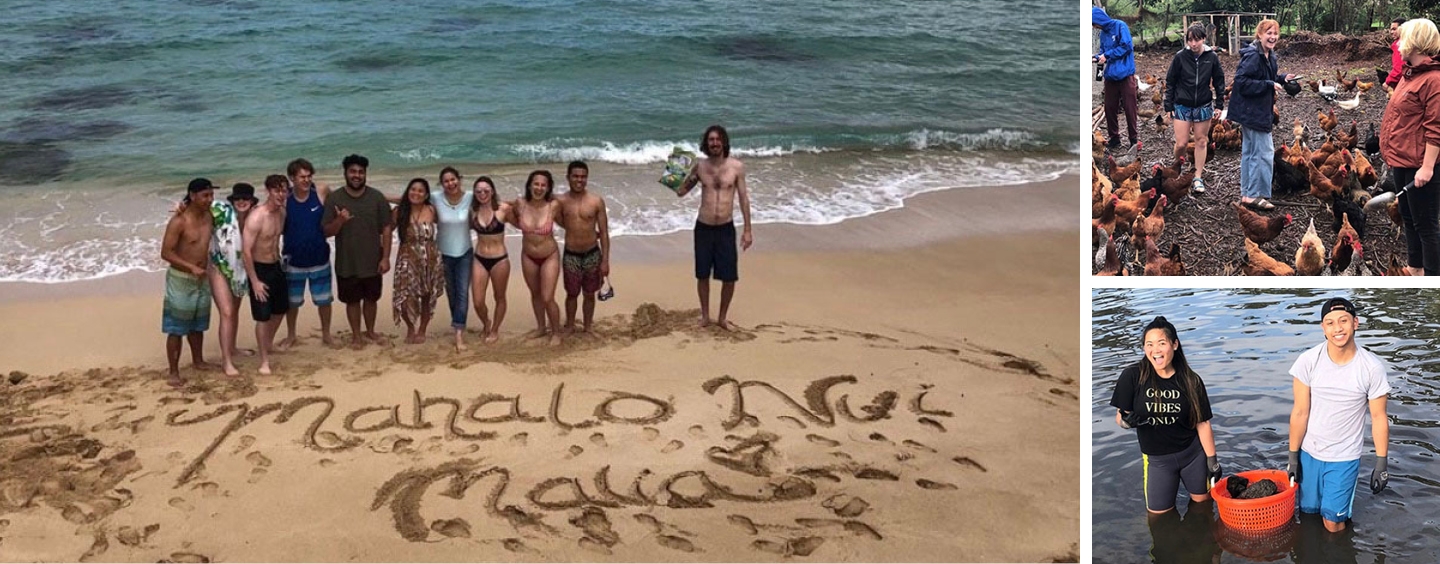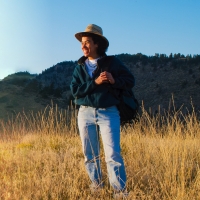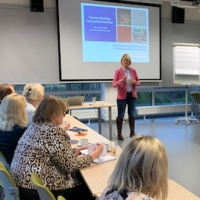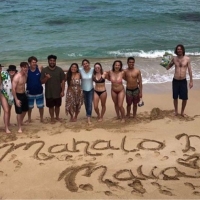RPT 470 Students Experience "Aloha Aina" in Hawaii

Students in travel class connect with the land during Hawaii field experience.
Students in RPT 470: Travel with Purpose spent winter break in Hawaii learning about Hawaiian culture. The course, open to all majors, provides an introduction and application of concepts related to socially responsible travel; community engagement; cultural competency; and sociocultural, environmental and economic sustainability through a mandatory 40-hour service learning experience.
The Hawaii field experience started off with welcome refreshments at Cafe Manifest, located in the historic Chinatown district (the oldest Chinatown in the U.S.), followed by a self-guided audio tour of the home of the Hawaiian Monarchy, the Iolani Palace. The group also learned the “aloha circle” and O’ahu mapping in the Kapi’olani Park, and ended the day with a swim at Waikiki’s Kamaina beach — a perfect place to learn how to do the Hawaiian Hakka.
At Mouna Farm Arts and Cultural Village, students learned how to discover “Mouna,” inner silence. They each contributed to the Kohola Ola Peace Project and witnessed the power of arts — arts being the vehicle for “building community spirit, unity and world peace."
Students joined more than 200 community members, scientists, cultural practitioners and storytellers at the 3rd Annual 'Aha ' Āina Aloha gathering at University of Hawai’i West O’ahu to honor the land. They left inspired to take conscious effort to connect to the land of their respective communities back in California.
At the Waianae Comprehensive Health Center, students had the opportunity to learn about the traditional Native Hawaiian healing, cultural education and traditions, and to practice Hawaii massage therapy and spiritual healing.
Students learned about the importance of food security and the skin benefits of a mud bath at the Ka'ala Farm Cultural Learning Center. In the 1970s kalo (taro) farming has been reintroduced to O’ahu and is a staple of traditional Hawaiian cuisine; poi is made from taro.
Students joined hundreds of local students and families during Ku’i at the Capitol 2020, a civic engagement and community event where participants can experience the cultural practice of poi pounding. The event has taken place annually on the opening of Hawaii’s Legislative session since 2011, after lawmakers passed SB101 allowing hand-pounded poi to be exempt from strict food processing guidelines.
RPT 470’s service learning experience at Mālama Loko Ea; Ancient Hawaiian Fishpond on the North Shore of Oʻahu was a rewarding experience. Nā Loko Iʻa "Hawaiian Fishponds" were built to be living refrigerators for the people who once lived solely from the land. These fishponds were meant to produce food, and now, they are being restored and improved to reintroduce traditional way of fishing back to Hawaii. Students assisted with the fish pond restoration by collecting rocks from the fishpond and even removing an invasive tilapia.
The last day, students enjoyed the beach, giving thanks. “Mahalo” means “thank you,” and in Hawaiian culture, it’s a way of life to be thankful for the richness that makes life so precious, and to embrace “Aloha Aina” — love of, respect for and genuine connection to the land.
Tags



